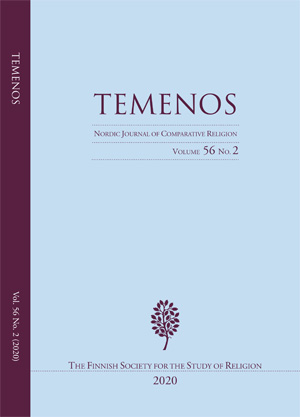Religious Affects and Female Subjects in the Altarpieces of the Finnish Artist Alexandra Frosterus-Såltin
A Case Study of the Jepua Altarpiece ‘Christ Appearing to Mary Magdalene’ (1906)
DOI:
https://doi.org/10.33356/temenos.82534Keywords:
affect, Alexandra Frosterus-Såltin, art history, Christianity, emotion, fin-de-siècle, Finland, iconography, religious art, women artists, women’s historyAbstract
Before the mid-nineteenth century there were few subjects in the altarpiece tradition of the Evangelical Lutheran Church of Finland in which the central figures accompanying Christ were female. Seldom used or new motifs involving female characters now emerged behind the altar. Most of the altarpieces with central women figures were painted in Finland at the turn of the twentieth century by the artist Alexandra Frosterus-Såltin (1837–1916).
In the nineteenth century Frosterus-Såltin was the only artist in Finland who realized the motif of ‘Christ Appearing to Mary Magdalene’ in her altarpieces. In her final representation of the theme, the altarpiece in the church of the Finnish Jepua commune, she chose an unusual approach to the motif. My interest in the subject lies in the motif’s affective nature – the ways in which altarpieces in general have been actively used to evoke feelings.
Moreover, I consider the influence that Alexandra Frosterus-Såltin, a significant agent in Finnish sacral art, had on consolidating the position of women’s agency in the Finnish altarpiece tradition. I examine the motif in relation to the cultural and political atmosphere of the era, especially the changing gender roles and the understanding of women’s social agency as the women’s movement emerged.

Downloads
Published
How to Cite
Issue
Section
License
Copyright (c) 2020 Ringa Takanen

This work is licensed under a Creative Commons Attribution 4.0 International License.
Author's Guarantee
- The Author acknowledges that the Work will be publicly accessible on the Internet and that such access will be free of charge for the readers.
- The Author guarantees that the Work is her/his original work that has not been published before and cannot be construed as copying or plagiarism. Furthermore, the Author confirms that the Work contains no statement that is unlawful, defamatory or abusive or in any way infringes the rights of others.
- The Author confirms that she/he has secured all written permissions needed for the reproduction in the Publication of any material created by a third party.
User Rights
Under the CC BY 4.0 license, the Author/s and users are free to:
- Share — copy and redistribute the material in any medium or format,
- Adapt — remix, transform, and build upon the material for any purpose, even commercially,
- However, the Work must be attributed to the original Author and source of publication.
The license of the published metadata is Creative Commons CCO 1.0 Universal (CC0 1.0)
Author Rights
The Authors maintain the right to:
- copyright, and other proprietary rights relating to the Work,
- the right to use the substance of the Work in future own works,
- the right to self-archiving/parallel publishing (publisher's PDF allowed).
Rights of Publisher
- The Publisher reserves the right to make such editorial changes as may be necessary to make the Work suitable for publication in the publication, e.g. style of punctuation, spelling, headings and the like.
- The Publisher will publish the Work if the editorial process is successfully completed and reserves the right not to proceed with publication for whatever reason.
- The publication entitles the author to no royalties or other fees. This agreement will be governed by the laws of Finland.






